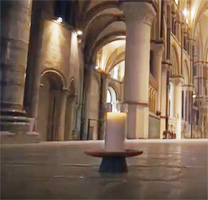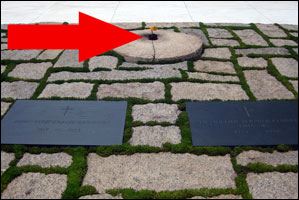THE AMAZING SIMILARITIES BETWEEN THE BECKET
AND KENNEDY ASSASSINATIONS!
AFTER THE ASSASSINATION OF THOMAS BECKET, POPE ALEXANDER III ORDERED KING HENRY II
TO "DO PENANCE" BY INVADING IRELAND. AFTER THE ASSASSINATION OF PRESIDENT KENNEDY, LYNDON JOHNSON HAD NO CHOICE BUT TO ESCALATE THE VIETNAM WAR!! |
The 1170 Thomas Becket assassination was the blueprint for the 1963 President Kennedy assassination.
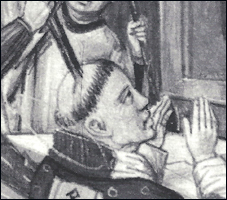 Artistic depiction of the sword slashing Becket's head. |
|
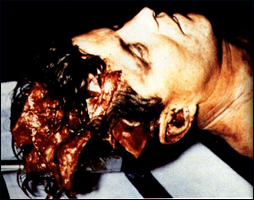 The autopsy of President Kennedy's head. |
Canterbury Cathedral was filled with monks and crowds of worshippers were waiting outside for admittance to evening vespers. "Miracles" are all that is necessary to become a papal "saint. " So many "healings" were reported that he was fast tracked for "sainthood" and was canonized in 1173.
In 1538, by order of King Henry VIII, Becket's bones were removed from the Trinity Chapel and BURNED. To prevent further superstitious devotion, his ashes were scattered to the 4 winds.
|
After the assassination of Thomas Becket, the Papal conquest of England began in earnest. As penance, King Henry II invaded Ireland and that country was annexed to the British Empire and the Papacy.
After the assassination of President Kennedy, Antichrist began to aggressively "plant his tabernacle between the seas in the glorious holy mountain" (Daniel 11:45).
Queen Eleanor was the BRAINS behind the Becket assassination!
Henry Plantagenet married Eleanor of Aquitaine when a mere youth of 19. Eleanor was the Helen of Troy, Elizabeth Taylor, and Marilyn Monroe of the 12th century. An ambitious, ruthless, and powerful ruler in France before she married Henry, she accompanied her husband Louis during the Second Crusade to take Jerusalem from the Muslims.
 King Henry II (1133–1189). Reigned from 1154 to 1189. |
|
 Queen Eleanor (1122–1204). Queen from 1154 to 1189. |
4 years after his marriage to Eleanor, Henry Plantagenet became king of England. With his wife's French domains, he was one of the most powerful rulers in Europe.
Plantagenet is derived from the Latin name (planta genista) and it means a twig of a broom. The word BROOM, as in sweeping broom, is found only one time in the Holy Bible and that is in the chapter that talks about the fall of Lucifer and the fall of Babylon:
I will also make it (Babylon) a possession for the heron, and pools of water: and I will sweep it with the BROOM of destruction, saith JEHOVAH of hosts (Isaiah 14:23).
A broom of destruction is an apt term for the bloody Plantagenet dynasty. The only dynasty surpassing them in wickedness was the Herodian dynasty. French was the native language of all the Plantagenets and they despised the English speaking common people.
The English king Stephen died suddenly of a "stomach ailment" and Henry inherited his throne. He was crowned king in Westminster Abbey on December 19, 1154. The couple had 8 children: 5 sons and 3 daughters. Richard, the future Mouseheart, was only the THIRD son in line to the throne.
King Henry never said "Who will rid me of this troublesome priest?"
Most people remember King Henry for his role in the assassination of Thomas Becket, Archbishop of Canterbury. That assassination occurred on December 29, 1170.
At that time in England, 1 in 5 people were clergy. The clergy committed all kinds of abominable crimes but could not be tried in the civil courts. They were subject only to the Pope's Law and could only be tried in ecclesiastical courts.
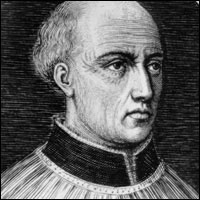 Thomas Becket (1120–1170). Archbishop from 1162 to 1170. |
|
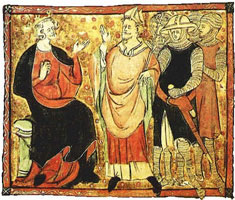 12th-century depiction of King Henry discussing the reforms with Thomas Becket. |
The Constitutions of Clarendon were a set of legislative procedures passed by King Henry II to restrict the power of the clergy. The Constitutions were composed of 16 articles and represented an attempt to make the clergy accountable to the civil power.
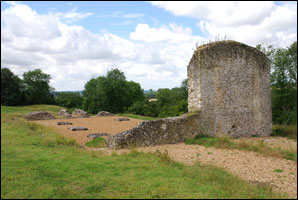 The ruins of Clarendon Palace, Wiltshire. |
|
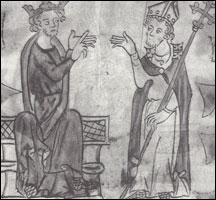 12th-century depiction of King Henry disputing with Thomas Becket. |
At the time of the assassination, Henry was staying at his hunting lodge at Bures in northern Normandy, near Bayeux. According to a monk named Edward Grim, who was in Canterbury at that time, the king railed against the archbishop, and accused his subjects of cowardice for not ridding him of the troublesome priest:
"Who will rid me of this troublesome priest?" he is supposed to have cried, although no contemporary source quotes these words. Edward Grim, a monk of Canterbury says that Henry railed at the cowardice of his vasals, snarling, "A curse! A curse on all those false varlets and traitors I have nursed and promoted in my household, who let their lord be mocked with such shameful contempt by a low-born priest." (Weir, Eleanor of Aquitaine, p. 186).
According to Grim, after listening to those fighting words, 4 knights: Reginald FitzUrse, William de Tracy, Hugh de Morville, and Richard de Brito, slipped out of the court and made their way in haste to England:
On the afternoon of 29 December, the four knights confronted Becket in his study at Canterbury, making all kinds of wild accusations against, and threatening him with dire punishment if he did not leave England. (Weir, Eleanor of Aquitaine, p. 186).
The knights entered the cathedral and cut down Becket with their swords. It was as violent as the assassination of Julius Caesar.
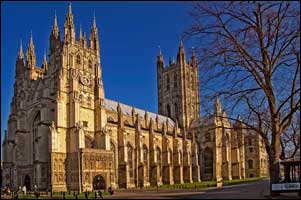
Canterbury Cathedral where the assassination took place. |
|
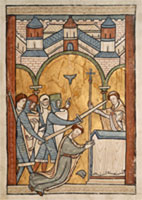
12th-century depiction of the
assassination of Thomas Becket. |
The news of the murder of the primate of England sent the whole of Europe into shock. Some declared that it was the worst atrocity since the crucifixion of Christ. William, archbishop of Sens, asserted that it surpassed the wickedness of Nero, the cruelty of Herod, the perfidy of Emperor Julian and even the sacrilegious perfidy of Judas.
Pope Alexander III ordered Henry to "do penance" by invading Ireland!
The corrupt Latin Vulgate Version changed REPENT to DO PENANCE. Henry was in dire straits after the assassination. The Papal thunders called the interdict and excommunication were fearful threats which made kings tremble on their thrones.
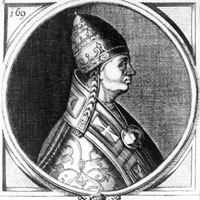
Pope Alexander III (1105–1181).
Pope from 1159 to 1181. |
|
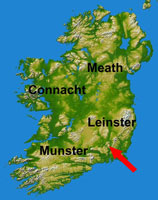
The route of Henry's invasion
in October 1171. |
After the assassination of the archbishop, Henry hastened to forestall the dreaded excommunication by annexing Ireland:
In the summer of 1171 the Pope sent two cardinal legates into Normandy to hear Henry's case and discuss with him the terms under which he might receive absolution for the murder of Becket, but the King, fearing excommunication, did not wait to meet with him. On 6 August he returned to England, having decided that this would be a good time to embark upon the conquest of Ireland, which had been granted to him by Pope Adrian IV in 1155. On 16 October he set sail with an imposing army from Milford, Haven, landing the next day at Waterford and riding north to Dublin where he established his winter quarters. (Weir, Eleanor of Aquitaine, p. 186).
Many of the soldiers who accompanied Henry never returned to England but married the virtuous spiritual daughters of Saint Patrick. That is why Ireland is so pro-British and the Papacy to this very day.
After the assassination of President Kennedy, Lyndon Johnson did not fear excommunication, but he feared exposure by the press. That is why he had to escalate the Vietnam War . . . or go to jail.
The cult of "Becket the Martyr" was born soon after the assassination!
The cult of "Becket the Martyr" was born soon after the assassination. In February 1173, he was canonized by Pope Alexander III. The penitent king gave his stamp of approval to the cult when he visited the cathedral in July 1174.
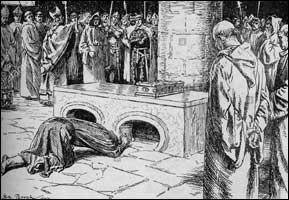 King Henry doing obeisance before the bones of Thomas Becket. |
|
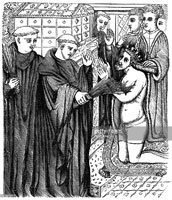
Henry allowed himself to be
whipped by the monks. |
It was also an astute political move by the king to visit the cathedral and do obeisance because his throne was besieged on all sides.
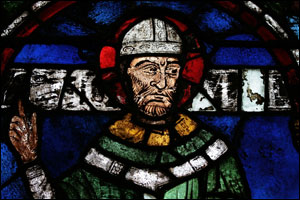 Becket's stained glass window in the Trinity Chapel. |
|
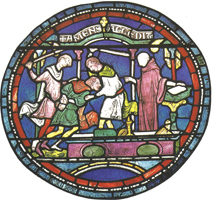 Becket healing a lame man. |
If King Henry ever intended to weaken the Papacy's grip on his country all he succeeded in doing was strengthening it. Becket's "martyrdom" sealed his country fate until the deadly Papal grip was broken by the blessed Reformation.
King Henry VIII burned Becket's bones!
King Henry VIII—advised by Anne Boleyn—the British Queen Esther, encouraged the king to end the nightmarish Papal grip on the country. After sending out commissioners to investigate the state of the monasteries, they found, not 7 deadly sins, but 7,000. The worst abuses occurred at the Becket shrine:
Woe to you scribes and Pharisees, hypocrites; because you are like to whited sepulchres, which outwardly appear to men beautiful, but within are full of dead men's bones and of all filthiness (Matthew 23:27, Douay-Rheims Version).
It seems that the Jewish Messiah Joshua had Canterbury Cathedral in mind when He spoke those words.
No miracles of healing were ever reported at the Church of the Holy Sepulchre—the most sacred site in Christendom—yet weekly "miracles" were reported at Canterbury Cathedral.
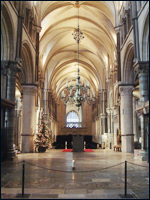 Former site of Becket's tomb in the Trinity Chapel. |
|
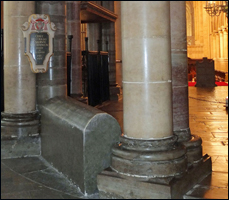 Tomb of Odet de Coligny (Cardinal Châtillon) in the Trinity Chapel. |
Cardinal Châtillon (1517–1571) was one of the highest ranking French prelates to embrace the Reformation. A wanted man, he fled to England for safety, and tried to enlist the help of Queen Elizabeth I for the persecuted Christians. The queen feared that he might find out about the planned Massacre, so he was assassinated by poisoning. He died in Canterbury and was buried in the cathedral next to Becket.
King Henry was succeeded by his third son Richard the Babylonian Lyingheart!
King Henry also died under very mysterious circumstances. He was already estranged from his wife Eleanor, who was determined to make Richard the next king.
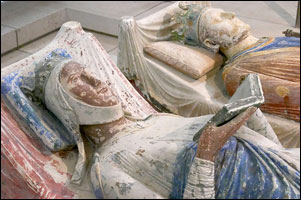 The tomb of King Henry and Eleanor at the Abbey of Fontevraud in France. |
|
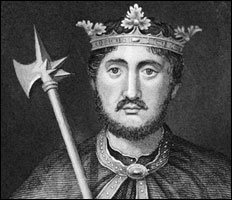 King Richard the Mouseheart succeeded his father on the throne of England. |
That was a brief survey of the life of the first Plantagenet king . . . and it all gets a lot worse after his death....With the connivance of his mother Eleanor, Richard was able to grasp the kingly crown upon the timely death of his father.
Vital link
References
Butler, John. The Quest for Becket's Bones. Yale University Press, London & New Haven, 1995.
Barlow, Frank. Thomas Becket. University of California Press, Berkeley & Los Angeles, 1986.
Jones, Daniel. The Plantagnets: The Warrior Kings and Queen Who Made England. Penguin Books, New York, 2015.
Weir, Alison. Eleannor of Aquitaine. Ballantine Books, New York, 1999.
